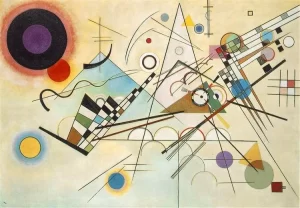What type of art was created during the Suprematist art movement?
Print and paintings were produced in the Suprematist Art Movement
Suprematism art was created and popular during which years?
1913 to the 1920s is when the Suprematist art movement was popular
Where was Suprematism art made and popularised?
The Suprematist Art Movement began in Russia and eventually spread to Europe
Who are some famous Suprematism artists and artworks?
Cow and Fiddle by Kazimir Malevich

Non-Objective Composition by Olga Rozanova

Composition 8 by Wassily Kandinsky

Interesting observations about Suprematism – Art Op-Ed
Kazimir Malevich is known as the father of Suprematism. He produced Suprematist work in 1913 in the USSR. Malevich’s painting “The Knife Grinder” was considered avant-garde because, unlike art movements in the past, he used geometry to express artistic emotions. You could say that Cubism is a close predecessor of Suprematism. However, Cubism leans towards subject interpretation in the form of shapes. On the other hand, Suprematism leans towards artistic expression in the form of geometric shapes. With Cubism, you could paint a tree in the form of square blocks. With Suprematism, you could paint sadness in the form of geometric shapes.
In Suprematism, the artistic feeling was of a superior focus compared to artistic depiction. Suprematism is kind of like if Cubism and Expressionism combined to form this geometrically structured, yet highly expressive art style.
Which art movement(s) came before the Suprematist movement?
Abstract art movement and Futurism came before Suprematism.
Which art movement(s) came after the Suprematist movement?
Constructivism art movement came closely after Suprematism.
Top 10 artworks in the Suprematism Art Movement:
“Black Square” – Kazimir Malevich (1915):

Kazimir Malevich’s “Black Square” is an iconic masterpiece that symbolises the essence of Suprematism. Created in 1915, it is considered one of the most radical artistic statements of the 20th century. The story behind this painting is as enigmatic as the artwork itself. Malevich saw the “Black Square” not merely as a single painting but as a concept, a breakthrough into the realm of the non-objective. In a sense, it marked the death of representational art and the birth of a new artistic language. Malevich presented “Black Square” in the top corner of a room during an exhibition, emphasising its transformative nature. The painting became a manifesto for Suprematist principles, challenging the traditional understanding of art.
“Suprematist Composition: White on White” – Kazimir Malevich (1918):

Another groundbreaking work by Malevich is “Suprematist Composition: White on White.” Created in 1918, it epitomises Malevich’s pursuit of pure abstraction. Malevich aimed to transcend colour, focusing solely on form and texture. He stated that white is not merely the absence of colour but a profound, infinite colour representing the supremacy of pure feeling. This painting, almost meditative in its simplicity, became a culmination of Malevich’s Suprematist vision, pushing the boundaries of artistic expression.
“Painterly Realism of a Football Player” – Kazimir Malevich (1915):

In this Suprematist work, Malevich explores the intersection of geometric shapes and the dynamic movement of a football player. This painting reveals Malevich’s fascination with the fourth dimension, a concept he believed could be accessed through art. The dynamic arrangement of shapes and colours represents not only the physicality of the athlete but also the artist’s quest for a deeper, transcendent reality.
“Suprematism” – El Lissitzky (1919-1920):

El Lissitzky, a key figure in the Suprematist movement, created a series of artworks simply titled “Suprematism” between 1919 and 1920. These works are a testament to Lissitzky’s innovative approach to Suprematism, incorporating elements of graphic design. The speciality behind these pieces lies in Lissitzky’s belief that art could go beyond traditional boundaries and become an integral part of everyday life. His Suprematist compositions, often seen as a bridge between fine art and graphic design, exemplify this revolutionary idea.
“Suprematist Composition: Blue Rectangle Over Red Beam” – Kazimir Malevich (1916):

This artwork by Malevich features a blue rectangle intersecting with a red beam against a white background. The focus here is on Malevich’s exploration of the emotional impact of colour and form. Each element in the composition is carefully placed to evoke a specific response, showcasing Malevich’s commitment to Suprematist principles of non-representation and pure feeling.
“Non-Objective Composition” – Olga Rozanova (c. 1917):

Olga Rozanova, a prominent Suprematist artist, created “Non-Objective Composition,” a vibrant and dynamic exploration of geometric forms and colours. These artworks are special because of Rozanova’s commitment to the Suprematist movement despite societal upheavals during the Russian Revolution. Her dedication to non-objective art as a means of expressing pure emotion and spirituality reflects the resilience and innovation of Suprematist artists during politically challenging times.
“Proun 19D” – El Lissitzky (1920):

El Lissitzky’s “Proun 19D” is a striking example of Suprematism’s influence on architecture and design. This work involves Lissitzky’s concept of “Proun,” an abbreviation for “Project for the Affirmation of the New.” Lissitzky envisioned Proun as a form of visual communication that went beyond traditional artistic categories. “Proun 19D” demonstrates Lissitzky’s fusion of Suprematist principles with architectural elements, illustrating his belief in art’s dynamic power.
“Suprematist Composition” – Ivan Klyun (1916):

Ivan Klyun, a Russian painter associated with Suprematism, created a work simply titled “Suprematist Composition” in 1916. This artwork highlights Klyun’s unique interpretation of Suprematism, incorporating biomorphic shapes and organic forms into his compositions. Klyun’s departure from the more rigid geometric shapes often associated with Suprematism reflects the diversity within the movement, showcasing individual artists’ interpretations and evolution.
“Dynamic Suprematism” – Kazimir Malevich (1916-1917):

Malevich’s “Dynamic Suprematism” is a vivid exploration of movement and energy through geometric abstraction. The uniqueness of this artwork lies in Malevich’s fascination with the dynamism of the modern world, especially the advent of machines and technology. The intersecting shapes and vibrant colours convey a sense of perpetual motion, capturing the essence of Suprematist principles in the context of an evolving society.
“Suprematism (Airplane Flying)” – Kazimir Malevich (1915):

This Suprematist work by Malevich features an aeroplane soaring against a white background. This painting reveals Malevich’s belief in the innovations of flight and technology. The aeroplane, stripped of realistic details, becomes a symbol of pure form and movement, embodying the Futurist and Suprematist fascination with the possibilities of a rapidly changing world.
Suprematism, with its emphasis on “pure feeling”, geometric abstraction, and the rejection of representational art, left an indelible mark on the course of modern art. The stories behind these famous Suprematist artworks provide insights into the artists’ innovative approaches, philosophical convictions, and their collective endeavour to redefine the very nature of artistic expression. The movement’s influence extended beyond painting, seeping into graphic design, architecture, and the realm of ideas, shaping the journey of artistic evolution in the 20th century.
*Images from Wiki Commons







0 Comments